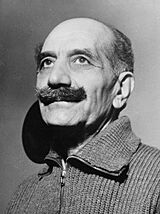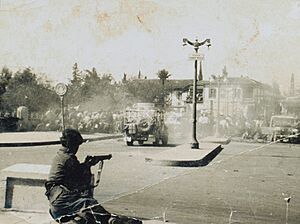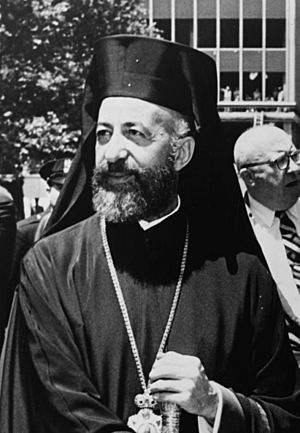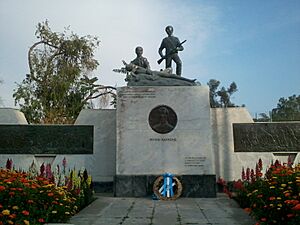EOKA facts for kids
Quick facts for kids EOKAΕθνική Οργάνωσις Κυπρίων Αγωνιστών National Organisation of Cypriot Fighters |
|
|---|---|
| Active | 1955–1959 |
| Ideology | Enosis Greek nationalism Anti-imperialism Anti-communism Religious conservatism |
| Political position | Right-wing |
| Leaders | George Grivas Grigoris Afxentiou |
| Headquarters | |
| Succeeded by | EOKA-B |
| Allies | |
| Opponents | TMT AKEL Black Gang 9 September Front |
| Battles and wars | Cypriot intercommunal violence Cyprus Emergency |
The Ethniki Organosis Kyprion Agoniston (EOKA /eɪˈoʊkə/; Greek: Εθνική Οργάνωσις Κυπρίων Αγωνιστών, lit. 'National Organisation of Cypriot Fighters') was a Greek Cypriot nationalist guerrilla organization that fought a campaign for the end of British rule in Cyprus, and for eventual union with Greece. The EOKA campaign played a crucial role in Cyprus's struggle for independence from British rule, but it also contributed to the complex political situation that continues to affect the island today.
Contents
Background
Cyprus, an island in the Eastern Mediterranean inhabited mostly by Greeks, was conquered by the Ottoman Empire from 1571 and remained under its control until 4 June 1878, when in the aftermath of the Russo-Turkish War, it was handed to the British empire. By that time, a sizeable Turkish minority population had also been established in the island. As nationalistic tendencies grew in both major population groups, Greek Cypriots advocated for Enosis (Union with Greece) which was a part of the Megali idea.
By 1915, the Greek Cypriots' opposition to British rule had increased, seeing that neither the British investment nor Enosis had materialized. In the beginning, the Enosis movement had only few supporters, mainly from the upper classes. However, that was about to change as two groups, disappointed with the new ruler, began to form. A number of Cypriots studying in Greece in the following years became strong advocates of Enosis upon their return.
On 21 October 1931, 5,000 Greek Cypriots, mostly students, priests and city notables rallied in the streets of Nicosia while chanting pro–Enosis slogans in what came to be known as the October Events. The revolt damaged both the Enotic cause and the Anglo–Hellenic relations. The Legislative Council and municipal elections were abolished, the appointment of village authorities and district judges was relegated to the governor of the island. Propagating Enotic ideas and flying foreign flags was banned as was the assembly of more than 5 people. Cyprus thus entered a period of autocratic rule known as Palmerokratia (Παλμεροκρατία, "Palmerocracy"), named after governor Richmond Palmer, which started shortly before the revolt and would last until the beginning of World War II.
Formation
EOKA was formed in 1955 and led by Georgios Grivas, a Greek Army officer who used the nom de guerre "Digenis". Grivas was a World War I and World War II veteran. During the Axis occupation of Greece in World War II, he led a small, anti-communist resistance group, named Organization X. The main goal of EOKA was "Enosis" - the union of Cyprus with Greece. The organization had Greek nationalist, religious, conservative, and anti-communist ideologies.
Activities
EOKA launched an armed campaign against British rule on April 1, 1955, with a series of bombing attacks on government offices in Nicosia. Their tactics included sabotage, ambushes, and assassinations targeting British forces, Greek Cypriot police officers, and those who opposed Enosis. EOKA's activities led to the declaration of a state of emergency by the British in November 1955. The insurgency caused significant unrest on the island and strained relations between Greek and Turkish Cypriots. EOKA's methods were controversial, with some viewing them as freedom fighters and others as terrorists. There were allegations of torture and extrajudicial killings by British forces in response to EOKA activities.
End of campaign
During the last months of 1958, all parties had reasons to favour a compromise. Greece was anxious that the ongoing situation could lead to a war with Turkey. On 5 December, the foreign ministers of Greece and Turkey acknowledged the situation and a series of meetings were arranged that resulted in London-Zürich Agreements. This was a compromise solution in which Cyprus would become an independent and sovereign country. On 9 March 1959, Grivas issued a leaflet declaring his acceptance to London agreements.
According to historian Heinz Richter, the activities of EOKA resulted in the death of 104 British soldiers, 54 policemen (among them 15 Greek Cypriots, 22 Turkish Cypriots and 12 British) and 238 citizens (among them 26 British, 203 Greek Cypriots and 7 Turkish Cypriots)
Impact
The EOKA campaign was largely successful in ending British rule. In 1960, Cyprus became an independent republic, though this did not fully resolve tensions between Greek and Turkish Cypriots.
Legacy
The authorities of the Republic of Cyprus consider the EOKA struggle as a struggle of national liberation and its members as heroic freedom fighters. The day of the beginning of the EOKA campaign, 1 April, is considered a national anniversary in the country today. Turkish nationalist narrative as written in a Turkish-Cypriot textbook considers the struggle of EOKA's guerrillas as barbaric and illegal with the conclusion that "Cyprus is and will remain Turkish" (p. 61)."
Museums and Monuments
A memorial museum dedicated to the EOKA campaign was created in 1960. It is located in the centre of Nicosia.
There are various monuments dedicated to the members of EOKA who died during the years of combat who are largely regarded as war-time heroes by Greek-Cypriots. Part of the central jail of Nicosia established by British governor Harding functions after the Cypriot independence as a museum. This includes the prisons cells, the gallows and the "Incarcerated Graves" of 13 EOKA fighters who were either executed or killed by the colonial authorities.
See also
- EOKA B
- Grigoris Afxentiou
- Evagoras Pallikarides
- Markos Drakos
- Michalis Karaolis
- Nikos Sampson
- Battle of Spilia
- Field Marshal Harding
- Migrated archives





